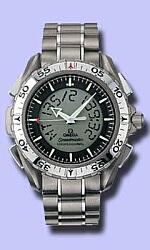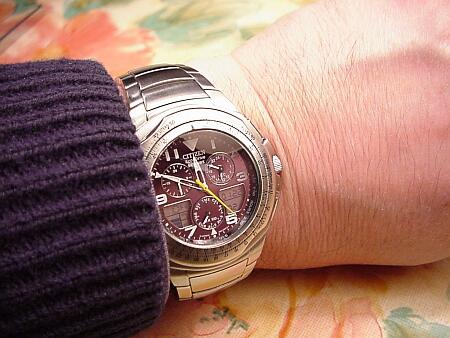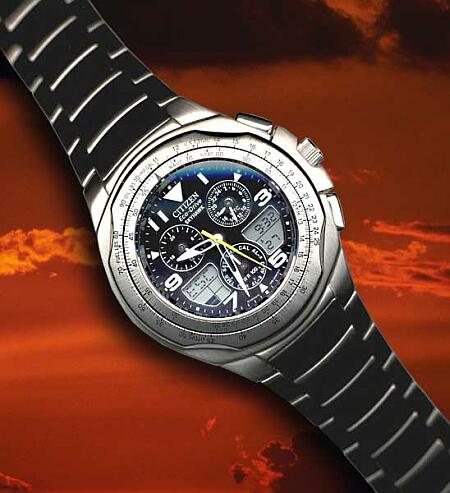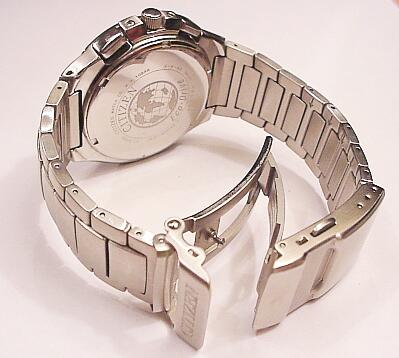
Nice, but is it worth two grand?

Ti Eco-drive Navi on Higuchi kevlar strap
|
Conclusions
The Skyhawk has many positive attributes, and some not so positive ones.
On the plus side, the case and especially the bracelet seem very well made for the price, with thoughtful attention to detail (except for not being able to close the clasp when adjusted to the 'tightest' position!). When adjusted properly, the bracelet is comfortable.
The cal.C650 Eco-drive movement is outstanding for its efficiency, accuracy and features. The fact that it is powered by light and has such a long sleep mode (up to four years) makes it in my opinion far superior to other hybrid quartz movements such as Seiko's kinetic, (even leaving aside Seiko's early problems with capacitor life).
I like the big and bold styling, and while it may never become a 'classic' design, it reflects the fact that this is a watch for the 21st century and the space age (goodness, was the moon landing over 30 years ago?!). OK, so maybe Omega can rightfully claim that their Speedmaster X-33 (the so-called 'Mars' watch) is flight-qualified by NASA and thus more of a candidate for the title 'space age watch', but it also costs ten times as much as the Skyhawk. At US$200, I reckon the Skyhawk is good value and represents a lot of watch for the money. Its accuracy has meant it has become the time reference for my other watches.
On the distaff side, it is a heavy watch, and after a long day my wrist can actually feel tired from lugging it around. This could of course be overcome by buying the more expensive titanium version. I believe Citizen had some quality control problems with the initial titanium examples, but things seem to have settled down now.

If ever a watch needed an anti-glare coating, this is it. The shiny black dial and domed crystal combine to make life difficult under certain lighting conditions, and a coating (or two) would greatly reduce reflections. However, since this may affect the charging efficiency, perhaps it just isn't possible.
I find mode-changing by twirling the crown fiddly and not as convenient as the Navihawk's pusher system.
These niggles aside, I still believe the Skyhawk is a great all-round watch, packed full of features—not the least of which is its 100m water resistance. Sure, you can get 200m water resistance and similar features in a Casio G-shock and other plastic-cased watches, and they're great for sports that are really tough on watches like cycling and rock climbing, but they don't have the looks and panache of the Skyhawk. As an example of this, the other day I was talking to a young computer salesman in a shop when he suddenly noticed the Skyhawk on my wrist. "Hey, love your watch!" he enthused. I was so astounded (and flattered) at anyone actually noticing what I was wearing that I took it off and passed it to him so he could have a closer inspection and feel the solidity. "Yeah, looks great," said he, peering at the dial to see the maker's name. "It's a Citizen" I offered. "Oh, a Citizen," he said, with just a little less enthusiasm. "I thought it was a Breitling—my boss is really into those, 'cos he goes flying and stuff. They're really cool." I didn't know whether to feel pleased because he thought it was a Breitling (possibly because of the slide-rule bezel), or miffed because he wasn't so enthusiastic about a mere Citizen. I reflected afterward that the Skyhawk can stand on its own merits, especially in the bang-for-buck stakes.
It seems a pity that many watchlovers dismiss electronic watches as soulless and 'designed by a machine'. I like to look at a beautifully finished mechanical movement as much as the next WIS, and can marvel at the ingenuity of the people who made it, but I think there's just as much (if not more) thought and skill that goes into researching and designing something as new and complex as the Skyhawk's eco-drive movement. We probably don't appreciate it so much because most of 'the gubbins' is hidden from us. You can see springs and cogs, you can't see electrons.
If you like complicated watches (and you do, don't you, else you wouldn't have read this far :)), get a Navihawk or a Skyhawk. If you've already got a Navihawk, still get a Skyhawk for the Eco-drive movement. Or perhaps you'd prefer to get one of the new Eco-drive Navihawks and have the best of both worlds!
Seiko used to have a saying about their quartz models, "One day all watches will be made this way." I hate to tell 'em, but they're wrong. If there's ever going to be only one way to make a watch, it'll be along the lines of the Eco-drive. I can't see anything coming anywhere near it in terms of its efficiency, accuracy, usefulness, easy maintenance, environmental friendliness, and price. Citizen are constantly working at refining and slimming down the Eco-drive movements, and researching ways of making the light-to-electricity conversion rate higher (it's presently running at about 20%). I can't think of any better way to power a watch—and that includes the body heat Thermic model that Citizen have just brought out. All they have to do to make it perfect is cut down on the reflections from the crystal and dial—and oh yes, I nearly forgot—include my Adelaide timezone, GMT+9.5h, so I don't have to keep remembering to add (or was it subtract) that odd half hour!

Photo courtesy of Brandon Sparks
|


